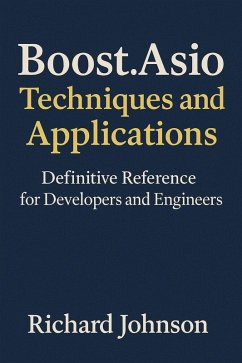
Tensor Structures and Applications (eBook, ePUB)
Definitive Reference for Developers and Engineers

PAYBACK Punkte
0 °P sammeln!
"Tensor Structures and Applications" "Tensor Structures and Applications" offers a comprehensive and rigorous exploration of tensors, guiding the reader from foundational mathematics to advanced, real-world applications. The book opens with a thorough treatment of the mathematical underpinnings, framing tensors as a natural extension of vectors and matrices through multilinear algebra, formal classification by order and type, and detailed conventions for representation and notation. Further foundational chapters bridge these ideas into the realm of differential geometry, introducing the calcul...
"Tensor Structures and Applications" "Tensor Structures and Applications" offers a comprehensive and rigorous exploration of tensors, guiding the reader from foundational mathematics to advanced, real-world applications. The book opens with a thorough treatment of the mathematical underpinnings, framing tensors as a natural extension of vectors and matrices through multilinear algebra, formal classification by order and type, and detailed conventions for representation and notation. Further foundational chapters bridge these ideas into the realm of differential geometry, introducing the calculus of tensor fields on manifolds, metric tensors, and their indispensable role in Riemannian geometry and general relativity. Building on these theoretical structures, the text presents an in-depth treatment of tensor decompositions, factorization strategies, and the algorithms that power high-dimensional data analysis. Special attention is given to the unique computational challenges posed by tensor methods, covering efficient data storage, parallel and distributed computing, automatic differentiation, and best practices in leading software libraries. These chapters serve both as a roadmap and a toolbox for researchers and practitioners working with complex, high-order data in numerical and machine learning contexts. The latter sections of the book survey an impressive array of contemporary applications, from signal processing and computer vision-where tensors enable sophisticated tasks such as multi-modal filtering and high-dimensional image analysis-to scientific computing, continuum mechanics, quantum information, and engineering simulations. "Tensor Structures and Applications" concludes by charting emerging research directions, including geometric deep learning, topological data analysis, and multiway network modeling, providing readers with both a solid foundation and a forward-looking perspective in this rapidly evolving field.
Dieser Download kann aus rechtlichen Gründen nur mit Rechnungsadresse in A, B, BG, CY, CZ, D, DK, EW, E, FIN, F, GR, H, IRL, I, LT, L, LR, M, NL, PL, P, R, S, SLO, SK ausgeliefert werden.













